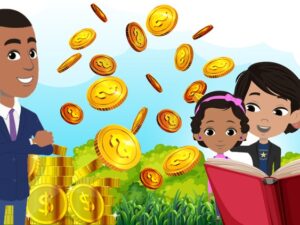Business Model Innovation: Differentiate & Grow Your Company
- Description
- Curriculum
- FAQ
- Reviews
- Grade

This course will give you plenty of practical business strategies and examples to improve any business!
The current economic turbulence is a wake-up call for businesses of all sizes : it’s time to innovate, to become more efficient, more resilient, and find new sources of growth. There are many ways to achieve these goals by improving existing business models.
In this course you will learn about Business Models: what are the different components of a business, it’s “system”, how it works. The Business Model Canvas is a great tool to map out and get an overview of how a business works.
You will also learn about business model innovation strategies and especially the “new” types of innovation used by startups and large corporations such as Design, Customer Niches, Sales & Delivery Channels, Customer Engagement, Processes and Revenue Models. They will help you find new sources of growth for your business and differentiate from competition. We will illustrate all these innovation techniques using dozens of recent examples from startups, small and medium businesses and large corporations.
This course is for :
1) Entrepreneurs & Startups
2) Small & Medium Businesses
3) Large Companies
For all the innovation strategies that we mention, we provide dozens of examples of how businesses of all sizes apply them. This Business Model Innovation course will give you many strategic insights into some of the best and most innovative business practices. You will be able to analyze any business, whether it is your own, the company you work for, or any other company, and brainstorm innovative ideas to accelerate its growth using business model innovation techniques.
There is also a special section at the end of the course where you will learn how to use ChatGPT and other Artificial Intelligence software as powerful research and brainstorming tools for your business. ChatGPT can be a great source of inspiration and ideas if you use it the right way.
(Disclaimer: The “Business Model Canvas” tool used in some parts of this course is used under Creative Commons license and attribution goes to Strategyzer. This course has no affiliation with and is not endorsed by the authors of the Business Model Canvas.)
Note: There are now “copycat” courses of this course. Some “instructors” used a similar name, content structure and examples. But as you can see from the amount of students and reviews, this is the true original course.
[Created by Business Disruptors]
—————————————————————-
In order to come up with the content for this course we worked with, analyzed and reverse-engineered many tactics of successful and innovative companies. You’ll see examples from Airbnb, Uber, Tesla, Twitch, Amazon, Spotify, Buzzfeed, Facebook, Google, Apple, Dyson, Reuters, Virgin, Tinder, Nintendo and many others!
Here are some of our reviews:
“The best course I have ever taken in innovation. I thank the authors for providing this very useful online Mooc.“
“Amazing content! Very clear. Wonderful examples of how strategies have been implemented by extremely successful companies. Throughout this course, I went back through my business model canvas and strategized how I could innovate in each of the 9 areas.“
“Enjoyed this course! Well done. Great brainstorming questions for new and mature business owners.“
“Really good course. I can recommend it to all new entrepreneurs!“
“Very relevant topic, nice to look at slides, concise & brief explanation – no fluff“
-
3Case Studies of Famous Companies + Facebook Group for the Course
-
4Introduction to the Business Model Canvas with Twitch.tv
-
5Who are your Customers? + Exercise
-
6What is the Value Proposition and how to define it
-
7Define your Sales & Delivery Channels
-
8How do you manage your Customers Relationships?
-
9Making money: The Revenue Streams
-
10Internal Operations: What are your Key Resources?
-
11What are your Key Activities?
-
12Who are your Key Partners?
-
13Understand your Cost Structure
-
14Conclusion & Recap
-
15How do Startups Disrupt Markets and Take Out Big Players?
In this part we will show you examples of how exactly the most innovative startups and corporations disrupt industries, and what happens to their business models when they do so. (Hint: they change some parameters of the most common business models in their industry to differentiate themselves).
-
16Examples of Disruptive Startups and How They Did It
Airbnb disrupted the hotel/accomodation industry. Tesla disrupted automobile. Spotify disrupted music. Amazon disrupted retail (and keeps disrupting it). Buzzfeed disrupted content. Transferwise and Lendingclub disrupted banking. Uber disrupted transportation. Facebook and Google disrupted advertising.... and there are many more coming.
-
17Bonus: Airbnb innovation model
-
18The most common (and difficult) type of innovation: just a "Better Product"
Product innovation such as "more features" or "better performance" is the hardest way to innovate because most of the companies compete in that innovation area.
-
19Introduction to innovative design - The reason behind Tinder and Uber success
Changing design can be a tremendous source of disruption. That's why Tinder succeeded in the overcrowded online dating market, or Uber in the transporation industry. More details in this part.
-
20Improve how a product looks - A better visual design for physical products
Examples: Dyson, Apple Watch, Ringly, Nest
-
21Improve interfaces - Better design for Websites & Online Software
Examples: Airbnb, Zefyr, Reuters TV, Bien'ici, Google Treks
-
22Improve interfaces - Better design of Mobile Apps
Examples: Clue, Auxy, Inks
-
23Design innovation - Halfway recap
-
24Improve the Customer Experience for "offline" businesses
Examples: Airbnb, Virgin Hotels, Soul Cycle, Hackaball
-
25Improve the User and Customer Experience for websites
Examples: Wikiwand, Transavia, Virgin America, Medium
-
26Improve the User Experience design for Mobile Apps
Examples: Uber, Tinder, Shyp
-
27Recap of Design Innovation
-
28Recap & Brainstormer's Cheatsheet - What to Remember about Offering & Design
-
29Bonus: Tesla Innovation Model
-
30Disrupting Customer Relationships - Introduction
-
31New ways to acquire your first-time customers
-
32Innovative ways to keep and grow existing customers
-
33Customer relationships - Conclusion
-
34Recap & Brainstormer's Cheatsheet - What to Remember about Customer Engagement
-
35Disrupting Customer Segments - Introduction
Tesla, Nintendo Wii and Kim Kardashian: Hollywood are all examples of disruption by "Customer niche".
-
36Focusing on an underserved market niche
-
37Creating a full new customer segment from scratch
-
38Recap & Brainstormer's Cheatsheet - What to Remember about Customer Niches
-
39Disrupting Sales & Delivery Channels - Introduction
The whole strategy and success of Amazon is based on Channel disruption from the beginning until the end.
-
40Disrupt the delivery channels of physical products
-
41Delivery of digital products + recap
-
42Digital Sales Channels
-
43Physical Sales Channels
-
44Channels Disruption - Conclusion
-
45Recap & Brainstormer's Cheatsheet - What to Remember about Channel Innovation
-
46New Product Development techniques
-
47Innovative Production techniques
-
48Case Study: Automation for Small & Medium Companies (Part 1)
-
49Case Study: Automation for Small & Medium Companies (Part 2)
-
50How to Find the Best Strategies for Any Business - Reverse Engineering Process
-
51Recap & Brainstormer's Cheatsheet - What to Remember about Process Innovation
-
52Disrupting Revenue Models - Introduction
Spotify is a flagship example of how changing Revenue Models can disrupt an industry. More examples in this part.
-
53Subscription models
-
54Freemium and Micropayments
-
55Advertising
-
56Affiliates and Franchising
-
57Revenue Models End and Recap
-
58Recap & Brainstormer's Cheatsheet - What to Remember about Revenue Models
-
59Share your own stories of innovative business practices!
-
60Necessity: Products that you need in your everyday life
-
61Loss Aversion: Not paying will result in a hassle or disadvantage
-
62Fear: Protect yourself from danger and accidents
-
63Convenience: Solve problems and save time
-
64Pleasure: Humans love to enjoy life
-
65Belonging and Vanity: Need for relationships and social status
-
66Scarcity: Rarity increases value
-
67Introduction to ChatGPT
-
68Innovate the Business Model Using ChatGPT
-
69Major Lessons From the Previous Exercise
-
70Use this Magic ChatGPT Prompt to Find Amazing Strategy Ideas
-
71Improve the User Experience Using ChatGPT
-
72Use ChatGPT to Find New Sales Channels
-
73Use ChatGPT to Improve Your Customer Journey
-
74Improve Your Website Copy and SEO with ChatGPT
-
75Innovate Your Product or Service Using ChatGPT
-
76Crazy and Fun Ideas to Try For Product Innovation with ChatGPT
-
77Product Design Innovation using Image Generating AI












